

Designing the Future of Girls’ Education
Classroom, Curriculum & Culture

A GDST Insights Report and Framework
About Us
The GDST is a global leader in girls’ education and the UK’s largest family of girls’ schools, with 23 independent schools and two academies. Founded over 150 years ago by four suffragists, we are pioneers and shapers of the future of girls’ education. We create schools where girls learn without limits so they can go on to lead lives without limits, in a world that is still far from equal.
Designing the Future of Girls’ Education
The Girls’ Day School Trust (GDST) is committed to sharing its expertise to improve the learning experiences and outcomes for ALL girls in education. Our landmark Girls’ Futures report in 2022 highlighted the aspirations of girls and the barriers to success that need to be addressed by the education system. The survey revealed that, typically, girls and young women are engaged and enthusiastic about the world around them. However, far too many felt unprepared for it and doubted their ability to affect change. The report raised questions about how schools might address these concerns. Two years on, Designing the Future of Girls’ Education, a GDST Insights Report aims to build upon our previous work by sharing practical insights into how the quality and delivery of girls’ education can be enhanced across all education settings, in all parts of the world1
Executive Summary
Sharing expertise and practical steps to remove gender imbalances in schools, enabling girls to reach their full potential
Designing the Future of Girls’ Education, a GDST Insight Report and Framework, provides a critical resource to review any structural gender imbalances and stereotypes in the classroom, enabling the full potential of girls whatever school they attend. This report offers expertise and practical steps, in the form of a framework that will help shape
and influence the education of girls.
Through conversations with a range of contributors, we have focused on three core principles for educating girls—classroom practice, curriculum and (school) culture—that can be applied in almost every educational context to enable future female leaders to achieve their full potential,
in whatever way they choose to define leadership and success.
We hope the insights from academic experts, researchers, teachers, students, and campaigners will inspire reflections on how these principles can help girls cultivate the skills they need to lead happy and fulfilling lives.
Designing the Future of Girls’ Education, a GDST Framework
It is an uncomfortable truth that gender equality is far from the norm in schools today. To accelerate the pace of change, the GDST has developed an evaluation framework. Focusing on themes raised from this GDST Insights Report: classroom practice; curriculum and (school) culture; the framework can be used by co-educational and girls’ schools, as well as families choosing a school for their child, to evaluate the school’s scale of progress to reduce gender imbalances and stereotypes.
Explore the framework on page 44 or download a copy at the QR code.

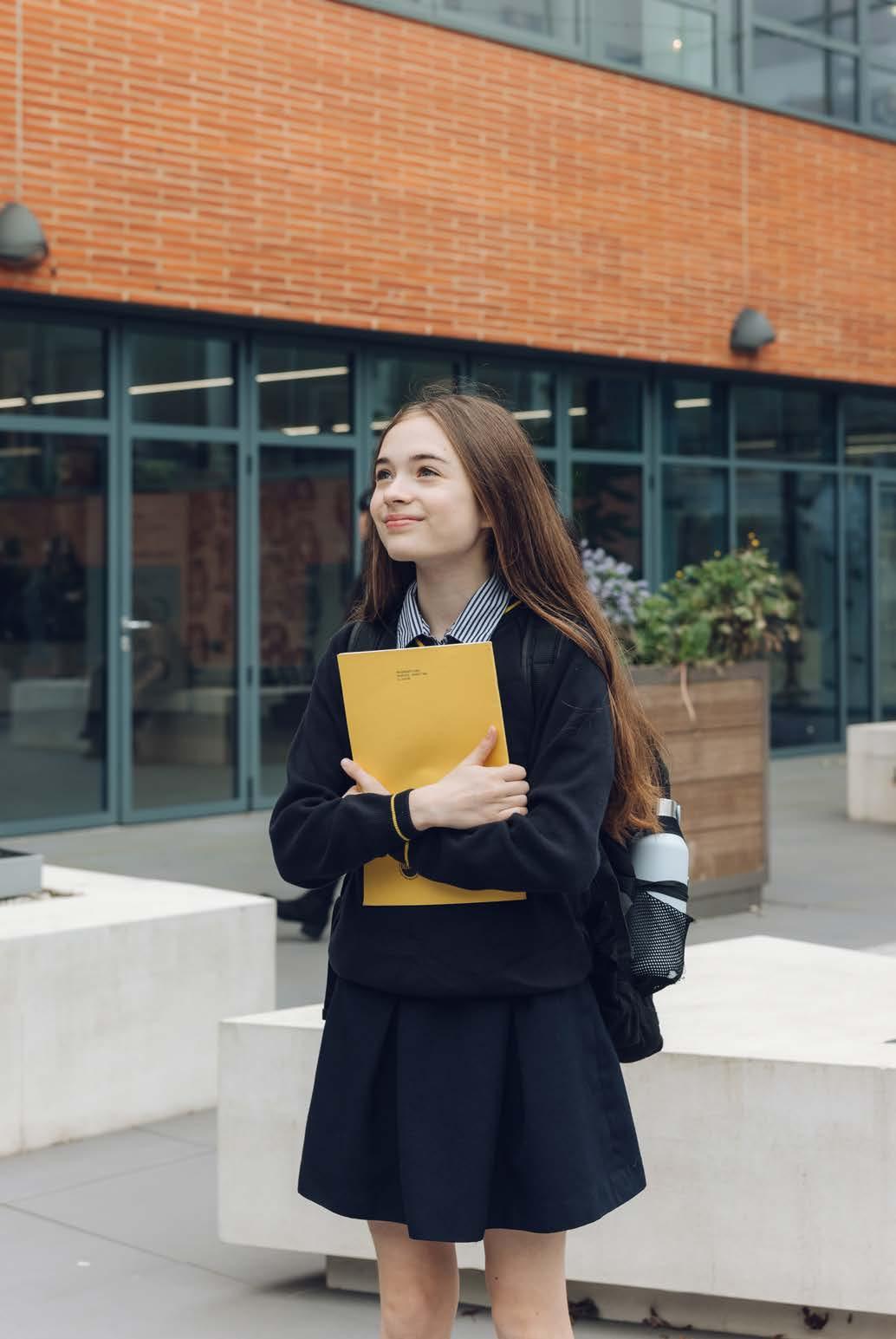
Designing the Future Cheryl Giovannoni
Chief Executive, GDST
Classroom, Curriculum & Culture
Over the past 152 years, the Girls’ Day School Trust (GDST) has sought to create environments where girls learn without limits. Our schools are girls’ schools by design, meaning we tailor our education to their needs and preferences. We do this from the moment they first walk through the door in the Early Years, to the start of secondary school, and into the Sixth Form. We believe that girls’ schools offer an opportunity to best prepare girls and young women for the world and that they remain relevant and crucial to helping close the equality gap, a process that the UN says will take more than 300 years to achieve.2
Evidence demonstrates that girls-only education works. The GDST is committed to being at the forefront of research into every aspect of educating girls and young women. We are continually seeking to demonstrate that girls-only schools benefit individual women’s outcomes and that
this form of education offers an environment free of the prejudice of gender stereotyping, while girls are encouraged to be ambitious and to take intellectual risks. Our previous research demonstrated that while we must be careful about generalising or stereotyping, teaching approaches and methods had
“We have access to the networks and knowledge to support better outcomes for all girls.”
– Cheryl Giovannoni, Chief Executive, GDST
developed organically within girls-only environments in a way that could be deemed ‘girl-friendly’.3
Through The Girls’ Futures Report in 2022, we sought to understand what matters most to girls today and how they feel about what lies ahead in their futures—in their personal and professional lives.4 The research found that from the age of 14 onwards, girls faced a significant drop in confidence, ambition, and preparedness for the future in comparison to girls educated in single-sex settings and boys in all types of settings. It enabled
us to identify several trends— not least that while all students faced the same confidence drop, there was a more pronounced recovery for girls educated in single sex schools, and for boys, as highlighted in The GDST Difference booklet.5
Our students recognise the power of an all-girls education, in school and later in life, when they have made their own strides out into the world. In the summer of 2023, a Year 12 [age 16-17] student at one of our schools reflected on “the privilege of learning within a liberal, femalecentred school”.
Of course, we know that not all girls will be taught in single-sex settings. However, as a valuesdriven organisation, we want all girls to learn without limits, and we believe we have access to the networks and knowledge to support better outcomes for all girls. That is why we said at the time of publishing The Girls’ Futures Report that we wanted to take our findings further and work with other equally committed partners in universities, businesses and schools to promote the educational interests of as many girls as possible, to help cocreate a more equal world.
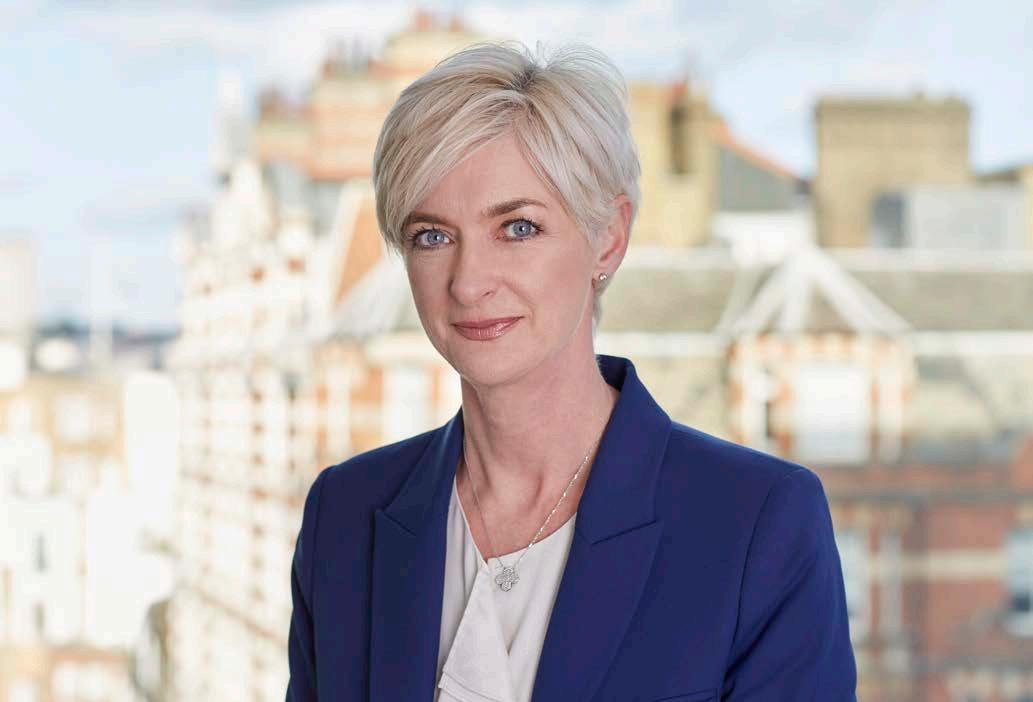
In parallel with this original research, we regularly update our compilation of worldwide research, published annually as ‘Why (and How) Girls Thrive in Girls-Only Schools’ 6 This underscores our findings by outlining the gender-specific challenges girls face in school and painting a picture of what a successful girls’ school looks like. In it, Dr Kevin Stannard (Director of Learning & Innovation at the GDST) says: “Today’s girls’ schools serve to subvert gender stereotypes and a priori assumptions by offering
an education designed for and dedicated to the development and empowerment of successful, happy, confident and adventurous girls and young women. Girls should have the opportunity to be educated separately not because they need protection, but because they deserve a level playing field.”
In this GDST Insights Report, we want to explore the precise configuration of that playing field. Through a century and a half of experience at the GDST,
we have developed a learning model that is about much more than single-sex education. It is a set of principles and practices that ensures girls are nurtured, challenged and empowered. If we are to close the gender gap, then we need to be clear that the structural gender imbalances out there in the world are reflected in and reinforced by the fact that, in many respects, the agenda in co-educational (hereafter, co-ed) schools is set by boys more than girls.
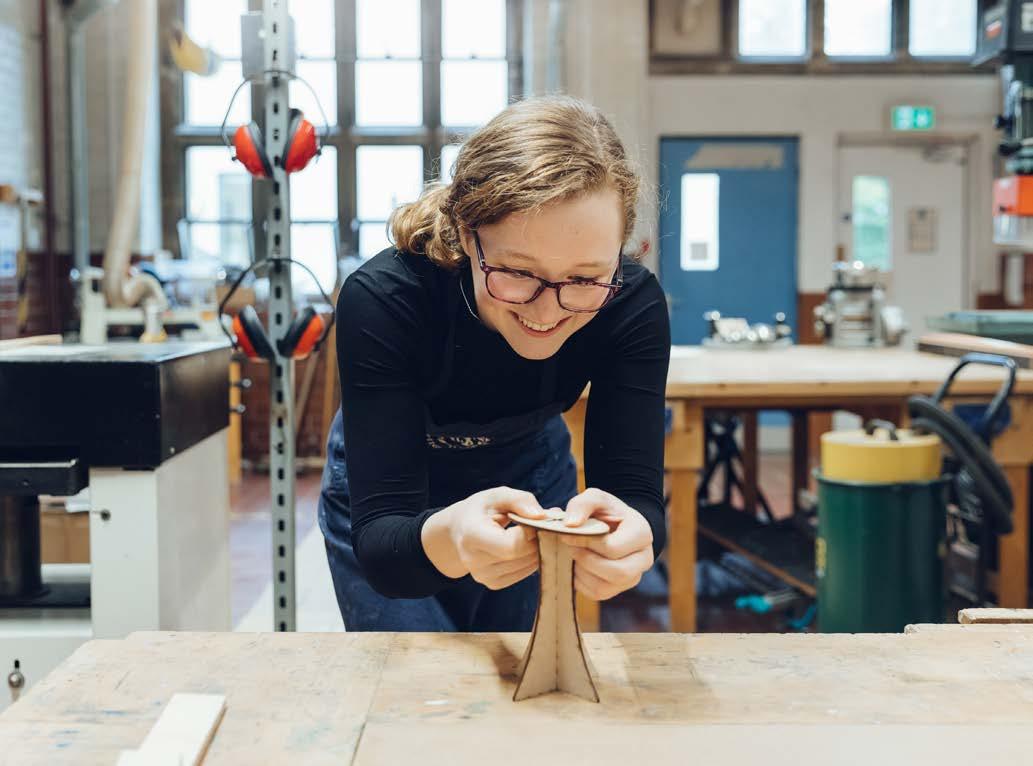
With the help of our contributors, this report extracts the most common themes that have emerged from our exploration of the three principles that support an outstanding education for girls—classroom, curriculum, and (school) culture—and packages them into a framework which supports educators to
ensure that girls can learn without limits. Dr Stannard concludes with this self-evaluation challenge and a rallying call—as well as some practical reflections—for schools to commit to reviewing all aspects of their student offering through the lens of gender equality and whole school inclusivity.
While The Girls’ Futures Report showed us what girls strove for in their future lives and careers, this report takes a deeper dive into the challenges raised, with the aim of informing and empowering teachers, as well as the whole educational community, to enable girls to realise their ambitions.
We felt it was imperative to include the voices of teachers in this GDST Insights Report, because teachers and educational support staff are arguably the most influential people who can calibrate the three principles we have identified to educate girls for future success. Their dedication and focus on helping the young people they educate achieve their full potential, regardless of their chosen career path, is apparent in every interview we conducted.
As you read this GDST Insights Report, we hope it becomes abundantly clear that greater respect for the teaching profession is the only foundation on which we can improve the quality of education for all young people across the country. We want to thank each contributor to this report for their invaluable observations and perspectives on the best ways to educate girls and for supporting the GDST’s continuing efforts to ensure that many of the persistent gender gaps in society are ultimately closed.
“Greater respect for the teaching profession is the only foundation on which we can improve the quality of education for all young people.”
– Cheryl Giovannoni, Chief Executive, GDST
Overview of Contributors
The insights we have gleaned from these interviews build on our previous research. We have aimed to capture the most significant and common themes, incorporating various perspectives. However, this paper is a partial sampling of extensive and rich conversations. From October 2023 to April 2024, we spoke with a range of academic experts, researchers, teachers, students/alumnae7 and campaigners—each of whom has shared either their lived experiences or research that they have conducted or found informative to their views on girls’ education, empowerment and equality.
Claire Bale
Head of Diversity and Inclusion at the GDST
Annabel Davies
Head, Croydon High School GDST
Marieke Forster Headteacher, Aylesbury High School
Nina Gunson
Head, Sheffield High School for Girls GDST
Hannah Harrison-Hughes
Head of Chemistry and Director of Academic Development, Howell’s School, Llandaff, GDST, and Trust Consultant Teacher for STEM
Dr Elizabeth Hicks
Principal, Girls Academic Leadership Academy (GALA)
Debbie Hill
Teacher of Modern Foreign Languages, Northampton High School, GDST and Trust Consultant Teacher for Research
Kitty Howie
Head of Academic Scholars at Croydon High School GDST
Caroline Hulme-McKibbin
Head, Kensington Prep School GDST
Kristina Lewis Deputy Head (Academic), Blackheath High School GDST
Rebecca Mahony Principal, Birkenhead High School Academy GDST
Paul Marshallsay Headmaster, Portsmouth High Prep School GDST
Hannah Morrell Director of Sport at Blackheath High School GDST and Trust Consultant Teacher for Sport
Julie Taylor Principal, The Belvedere Academy GDST
Jake Unwin
Head of History at Sutton High School GDST and Trust Consultant Teacher for Humanities
Sixth Form students Portsmouth High School GDST
Alumna Sheffield High School for Girls GDST
Sixth Form student Nottingham Girls’ High School GDST
Professor Almudena Sevilla Professor of Economic and Social Policy, London School of Economics
Dr Karen Skilling Associate Professor, Department of Education, University of Oxford
Professor Sarah Smith OBE Head of Economics, University of Bristol
Dr Jessica Wade Research Fellow, Imperial College London (GDST alumna)
Cath Bishop Former Olympic rower and leadership expert
Sherry Coutu CBE Founder, Founders4Schools and Maths4Girls
Edwina Dunn OBE Founder, The Female Lead
Charlotte Keenan Head of the Office of Corporate Engagement International and 10,000 Women UK, Goldman Sachs
Rishi Khosla OBE Co-founder and CEO, OakNorth Bank
Megan Murphy Global Executive Director, International Coalition of Girls’ Schools (ICGS)
Mary Ann Sieghart Broadcaster and author of The Authority Gap: Why Women Are Still Taken Less Seriously Than Men, and What We Can Do About it
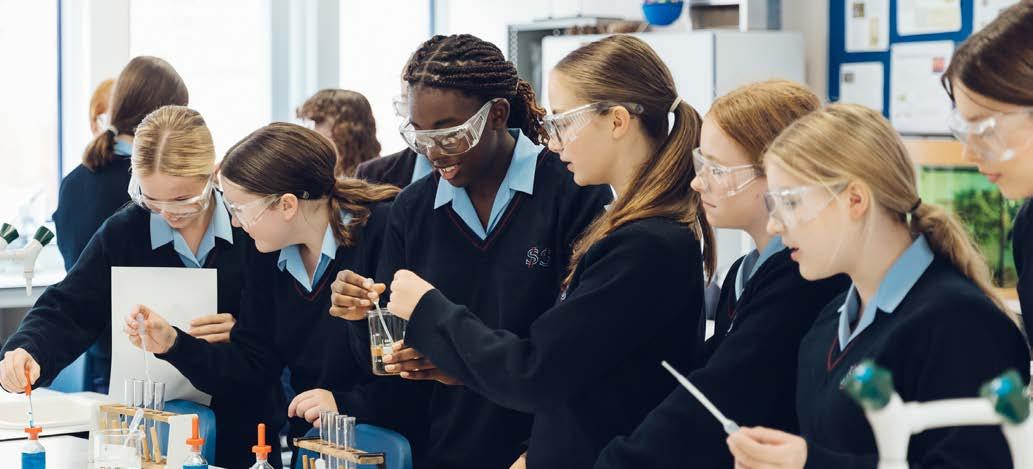
Girls in the Classroom
In this section, we urge all those involved in education to do everything they can in the classroom to close the gap in authority and confidence between boys and girls. Our contributors provide illuminating accounts of how they encourage girls to find their voice and then use it with conviction and courage. What follows emphasises discussion and collaboration, in tandem with embracing complexity and failure, as paramount to enabling girls to learn without limits.
Addressing Gaps in Girls’ Authority & Courage
Our previous publications summarised research, which demonstrated that girls appear to be consistently under-represented in co-ed classroom interactions, with a disproportionate amount of attention going to a small subset of more demanding boys.8 This is borne out in the experiences of educators.
Rebecca Mahony shared with us her experience of teaching in co-ed environments before moving into girls’ education as the Principal of Birkenhead High School Academy GDST: “The boys often had no clue what some of the answers were, but they were all putting their hand
up and having a go. That is not a criticism; it’s great that they were willing to try and not afraid to get it wrong. Sometimes, I knew that some of the girls had the answer, but for fear of failure, not a single one put their hand up. And these were confident, articulate, intelligent young women.”
“You see it a lot in co-ed schools where boys are often jumping out of their seats, shouting that they know the answer,” says Dr Elizabeth Hicks, founder of the Girls Academic Leadership Academy (GALA) in Los Angeles, the first all-girls public (i.e. statefunded) school in LA’s Unified School District.
Schools, in their gender imbalances, reflect the real world. Research of the US Supreme Court between 2004-15 found that female justices were interrupted three times more than their male counterparts, despite making up on average just 24% of the bench in that period. According to transcripts of the Supreme Court’s oral arguments in that time, 96% of interruptions were made by the male justices.9 Author of The Authority Gap: Why Women are Still Taken Less Seriously than Men, and What We Can Do About It, Mary Ann Sieghart, speaking to us for this paper, laments that “an interruption is
a lack of respect for the person who is speaking. It is a clear measure of the authority gap.”
Of course, this gap does not exist in girls-only schools; the challenge for co-ed settings is how to close it.
Our previous research has also shown how girls adapt their behaviour in the presence of boys in school. This is often to their disadvantage, for instance, by adopting supporting or moderating roles in discussion and needing to be more active about risk-taking in inquiry.10 Perhaps this is because, as Sieghart argues: “Women are twice as likely as men to say they need to provide evidence
of their competence, and this goes even further for non-white women. This is despite academic results broadly showing that girls outperform boys on the whole. And yet, they have to prove themselves more, so they’re less likely to be listened to in group discussions and more likely to have their expertise challenged.”
Acknowledging such culturally ingrained biases is crucial to understanding the confidence gap that exists in co-ed settings between girls and their male peers.11 This raises the question of how to cultivate a learning environment—co-ed or singlesex—that encourages girls to find their voice and empowers them to use it with conviction.
Nina Gunson, Head of Sheffield High School for Girls GDST, says that confidence is an outdated metric. Speaking to the missiondriven nature of her school, like others in the GDST, she outlines its three core values: positivity, kindness and courage.
“Originally, we considered confidence instead of courage,” Gunson explains. “But many of our girls said that confidence felt more like a personality trait and that some students are not overtly confident or extroverted, and that isn’t something that needs to be changed. What could be changed, though, was taking themselves out of their comfort zone and trying things they are not always confident about. That requires courage.”

Professor Almudena Sevilla of the London School of Economics agrees: “Encouraging girls to be outspoken, for example, can backfire due to stereotypes that label outspoken girls as confrontational and outspoken boys as self-confident. We must challenge these stereotypes, as well as the notion of outspokenness as the sole path to success.”
Academics Shani Orgad and Rosalind Gill have similarly argued that the female “confidence culture” is more to do with entrenched, oppressive, social injustices that need to be addressed.12
While a discussion about how to do so is beyond the scope of this report, it is right to acknowledge that girls in our classrooms will be affected by culturallyencoded expectations of how they are expected to behave. Against this backdrop, Head Caroline Hulme-McKibbin has
been working with her juniorage students at Kensington Prep School GDST on redefining what it means to be a ‘good girl’. “There is an expectation or at least a perception,” she argues, “that girls should follow the rules, sit down, be quiet and not cause any behaviour issues in a school setting. We wanted to understand whether these ideas were embedded in our girls here.”
Kensington Prep found that girls as young as Year 4 [age 8-9], exhibited the opposite of traditional expectations, saying that a ‘good girl’ spoke for herself, said ‘no’ when uncomfortable, and should be both seen and heard. “We had one amusing anecdote when a teacher asked one of our girls if she could stay and help her tidy up after class,” McKibbin adds. “The student responded, ‘Are you asking me because you want my help or because I am a
good girl, and I should just do it?’
We see that as a really positive engagement because she wasn’t rude. She was just following on from what we had asked them to question—whether she should comply because you’re expecting her to be a good girl, or are you genuinely engaging with her and saying it would be great to work together?”
The discussion around courage and voice warrants particular consideration, especially for girls who are naturally more introverted. It is right and proper that we help students be courageous and use their voices in a way unique to them while respecting and celebrating their differences.
Kensington Prep found that as young as Year 4, girls exhibited the opposite of traditional expectations, saying that a “good girl” spoke for herself, said “no” when uncomfortable, and should be seen and heard.

Nurturing Collaboration & Discussion
The Girls’ Futures Report noted that girls’ learning needs, preferences, school experiences and leadership styles tend to be different from those of boys.13 Typically, girls prefer cooperative, discussion-led learning environments and adapt better to coursework tasks and collaborative, project-based activities. Kitty Howie, Head of
Academic Scholars at Croydon High School GDST, observes this phenomenon regularly in the ‘Stretch and Challenge’ programme she oversees. “Something fascinating to me”, she notes, “is how the students involved don’t seem to compete with each other by trying to be the ‘best’—rather, they seem to present themselves
as a group who take collective responsibility for their excellence. They don’t try to outdo each other but instead support and motivate one another, cheering each other on. It’s a fabulous experience where we are one living, breathing and flourishing ecosystem. All I have to do is get the seeds in the soil!”

“Peer learning increases autonomy in the learning experience – having a voice, feeling you belong to a group, focusing on learning rather than exam outcomes.”
– Cath Bishop, Former Olympic rower and leadership expert
We must educate girls— particularly those in co-ed settings—to maximise their contributions when undertaking group work. This is particularly important as research shows that girls’ input is affected by group composition, especially when they are working alongside boys. For example, a Dutch study examined cooperative problem-solving among 15-yearolds in physics lessons and the influence of the partner’s gender on students’ learning outcomes. The study concluded that girls do better in all-female groups than in mixed-gender groups when learning to solve physics problems.14 Simply put, group dynamics matter, for girls at least.
Cath Bishop, a former professional rower and Olympic medallist, who since retiring from rowing, has become a leadership and culture consultant, calls for a shift in approach in the curriculum, with peer-to-peer learning at its heart, so that teamwork skills are built into the structure of the school day. As well as building teamwork skills, cooperative learning creates greater engagement in learning through being more intrinsically motivating. “Peer learning increases autonomy in the learning experience – having a voice, feeling you belong to a group, focusing on learning rather than exam outcomes. These are intrinsic motivators, but our education system currently works on an extrinsic level, which is too shallow,”
Bishop says. “It therefore demoralises and disengages students. Extrinsic-based learning doesn’t motivate us deeply enough to develop those key skills identified by The World Economic Forum of creativity and resilience that will be essential to the future workplace.” If any such approach is to be successful, however, the gender of the group members needs to be taken into consideration, and all group members need to be taught the intricacies of group communication— girls in co-ed environments even more so. Amongst other things, participants need to understand the individual characteristics of the group, such as communication preferences, neurodiversity, and background.

they were not confident engaging with people who have different views from their own.15
At Blackheath High School
of respondents to our Girls’ Futures survey said they are confident they know what to do when they see fake news.
Encouraging active learning, emotional literacy and resilience allows girls’ schools to innovate how they teach core subjects and to do so in a more collaborative way—one which makes sense for a future that will be much less about what we know, and far more about being able to judge whether that knowledge is true or not. Only 40% of respondents to our Girls’ Futures survey said they are confident they know what to do when they see fake news, and almost a third said
GDST, Deputy Head, Academic Kristina Lewis has designed an enrichment programme for students in Years 7-9 [age 1114] where they explore what ‘disagreeing well’ looks like and how to engage in civil discourse. This involves explicit instruction in what ‘oracy’ is, including the cognitive, linguistic, social and physical.16 A focus on active and genuine listening means students give feedback for correcting what has been heard to ensure they respect the other person’s autonomy and let them control their narrative.
is crucial in an age dominated by social media, where online debates can quickly dissolve into toxic exchanges. By disagreeing with respect, we are encouraging students to contribute to a culture of healthy discourse.
The same approach has been taken at the all-girls grammar, Aylesbury High School, where an oracy lead is employed to support the students in learning how to use their voices and develop the ability to communicate, question, and express themselves clearly and confidently. 40%
Lewis notes: “As we prepare our students to be the future leaders, thinkers and contributors to society, mastering the art of disagreeing well empowers them to navigate the complexities of the modern world. It strengthens their ability to solve problems collaboratively, fosters resilience in the face of adversity and ensures that their voices contribute meaningfully to dialogue.”
By focusing on the issues at hand, rather than attacking the person expressing an opposing view, the school is helping students to form another essential skill, enabling them to critique ideas without resorting to personal insults and unhelpful exaggeration. This principle
“By disagreeing with respect, we are encouraging students to contribute to a culture of healthy discourse.”
– Kristina Lewis, Deputy Head (Academic), Blackheath High School GDST
“We want to help our students recognise misogynistic traits and break down ideas of what a coercive or abusive relationship might look like.”
– Rebecca Mahony, Principal, Birkenhead High School GDST
Students we spoke to who currently or recently attended a GDST Sixth Form, having previously been in co-ed settings, agree that they have since experienced more collaborative and discursive approaches:
“The debates, conversations and relationships you have with everyone in the class, not just your friends, are good because everyone is supportive of you, which wasn’t there for me in co-ed. Before, I might think, ‘Oh, that’s a stupid question. Don’t ask that because others might judge me,’ so I wouldn’t ask it. But now I say to myself, ‘No, I’ll ask it and I’ll see.’”
– Sixth Form student, Portsmouth High School GDST
“I feel like the lessons are tailored to how I learn and how I take in information. It means I’ve got a lot more confidence coming in and being able to ask questions and ask for help. If I tried to ask a question at my previous school, I would worry I would be laughed at, but I haven’t worried about that once in the two years I have been here.”
“A lot more of my classes are discussionbased. So, in English, when we’re annotating, we’ll do it in a group; it won’t just be the teacher speaking to us while we take notes. It encourages us to ask more questions and is more discussion-based. I feel like that works better for me and how I learn.”
– Sixth Form student, Nottingham Girls’ High School GDST
“I have found being at an all-girls school a lot less disruptive. It felt like all the girls I was learning with were doing so in a similar way to me. We were all very focused. We had similar goals and it just felt more friendly. Teenage boys can be quite boisterous, can’t they? So, it removed that boy drama.”
Birkenhead High School GDST’s Rebecca Mahony also identifies the importance of addressing prejudice against women that colours contemporary debate: “We want to help our students recognise misogynistic traits and break down ideas of what a coercive or abusive relationship might look like, so that girls can speak comfortably about it. We try to have those conversations, but they must also happen from the other side in both boys’ and co-ed schools.”
This idea exemplifies a recurring theme identified throughout our findings: some topics, themes or areas may be best or, more efficiently, approached and communicated in single-sex environments, at least in the initial stages, where students feel comfortable being themselves.
Another approach to developing girls’ oracy, used widely at
Mahony suggests: “Perhaps the initial work can be done separately. Then, once girls are more confident in understanding and speaking about this subject, bringing them into the same space so that the girls can explain how that sort of behaviour may make them feel. That could be very powerful.”
Birkenhead, is a ‘no hands up’ culture, as Mahony explains: “The teacher selects a different student for each answer. It means you get all the children involved in the lesson rather than ‘pick me’ students, who are more likely to be boys in co-ed environments. And if you know your students well, you can manipulate it so that you only choose girls when they’re likely to know the answer or put them into groups they are comfortable with. By doing this, you are encouraging their oracy and creating a culture of speech development in school.”
– Sixth Form student, Portsmouth High School GDST
– Alumna, Sheffield High School for Girls GDST
It is incumbent on all educators to find ways to nurture and develop girls’ voices, especially during discussions, where traditionally, their voices are most likely to be unheard or lost. We appreciate that this is easier said than done in a co-ed context, but it is possible. The rewards for finding and developing girls’ voices certainly warrant the effort because it enriches not just the lives of the pupils involved but that of the whole school community.
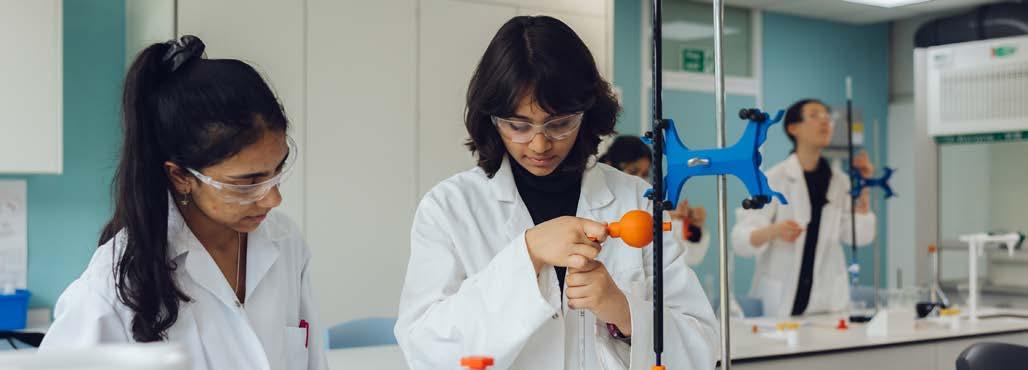
Teaching Girls to Embrace Complexity & Failure
The World Economic Forum finds that analytical and creative thinking are the top two most important skills needed by 2027, with others in the top 10, including resilience, flexibility and agility, curiosity and lifelong learning.17 Planning activities to foster these skills in the curriculum can significantly affect students’ academic development and resilience, especially when such tasks contain an appropriate level of challenge.
Caroline Hulme-McKibbin, Head of Kensington Prep School GDST, says: “We set up activities to almost be deliberately awkward, to make the girls think about how to solve a problem or find a solution. We do emotional literacy work right from reception, which we feel is crucial to give the vocabulary to describe and embrace their emotions. I think young girls often behave in a way that they think other people expect them to and therefore mask their emotions.”
All of this adds up to ensuring that when Kensington Prep’s students go on to secondary school, they will have the tools to protect themselves, put their voices across in a confident yet non-confrontational manner and maintain healthy relationships.
Dr Elizabeth Hicks takes the same approach at Girls Academic Leadership Academy in Los Angeles: “We say to the students, you have more than one chance to show you can meet the standards. We don’t just teach something once and move on, saying, ‘You failed; that’s too bad’. We keep building on the curriculum and help girls know they can try again if they didn’t get it the first time.”
Writers have variously pointed out that girls are encouraged to be compliant, accomplished and driven—to project a kind of ‘effortless perfection’.18 This is perhaps one reason girls dislike being wrong or making mistakes. We should do all we can to expose girls to failure and make mistakes to normalise these outcomes as a natural part of the learning process and a crucial driver of progress.
Aylesbury High School is also working with its students to develop skills that will prepare them for a world where AI and social media play a more significant part: “Getting our students to look creatively and critically at the information they’re given is imperative,” says Headteacher Marieke Foster. She highlights an example
of a discussion group where “students analyse resources that are coming to them, to think critically about where the sources come from and what they should do with that information”.
With the UK coming 13th in the 2023 Media Literacy Index, much work is needed in this area.19 Education drives improved criticality and girls’ schools lead the way.
By 2027
Analytical and creative thinking are the top two most important skills needed, according to The World Economic Forum.

The Curriculum & Co-Curriculum
This second principle explores the importance of delivering a forward-focused curriculum and co-curriculum that removes barriers, breaks stereotypes and develops essential skills for girls.
Science, Technology, Engineering & Maths (STEM)
A crucial part of improving equality is removing barriers to STEM subjects for girls during their time at school. The Institute of Physics found that fewer than 2% of girls in UK schools go on to study A Level physics, compared to 6.5% of boys.20 More than two-thirds of co-ed schools have fewer than two girls in each year taking this subject, and of all science and maths subjects, biology is the only one where female participation is higher than male.
“There are a multitude of factors as to why girls do not take up STEM at the same rates as boys,” says Dr Karen Skilling, Associate
Professor in the Department of Education at the University of Oxford. “It could be familial, cultural, social, or even utility related—in terms of not seeing the value it has to their future.”
However, the Institute of Physics found that the percentage of girls in single-sex independent schools who take up A Level physics (7.5%) is higher than that of girls and boys nationally. These trends are global. Research from the United States, for example, finds that almost half (48%) of girls in single-sex schools rank their maths ability as above average compared to 37% of girls in co-ed schools; 36% give
themselves the same ranking in computer science compared to 26% in co-ed classes, and female alumnae of single-sex schools are three times more likely to report they intend to pursue a career in engineering than their peers in co-ed schools.21
So, what is happening within girls’ schools that is encouraging a higher uptake of, and a greater self-confidence in, STEM subjects? At GDST schools in 2021, more than 60% of Year 13 [age 17-18] students across our 25 schools sat A Levels in one or more STEM subjects, with 39% of all GDST students taking A Level maths.
For Hannah Harrison-Hughes, Head of Chemistry and Director of Academic Development at Howell’s School, Llandaff GDST, and Trust Consultant Teacher for STEM, a “girls-only education affords them the freedom to express their enjoyment of STEM subjects, silently giving permission for other girls to do the same. Combined with teachers who are not only aware of the gender imbalance in STEM but are wholeheartedly committed to dismantling it, GDST schools are places where girls’ interest in STEM is thriving.”
A GDST alumna, who attended Sheffield High School for Girls GDST in Sixth Form having previously attended a co-ed school, says that she chose to take maths and biology for A Level because she “felt more comfortable being in a room with other girls that were like me, rather than one of just a few in a
science or maths class. It removed the stereotype.” Julie Taylor, Principal of The Belvedere Academy GDST, adds that the absence of boys in the classroom means that subjects are never perceived as gendered: “We get great numbers for maths and science A Levels. It doesn’t even enter the girls’ heads that they shouldn’t do it, because the concept of a girls’ or boys’ subject doesn’t exist.”
Marieke Forster, Headteacher of Aylesbury High School, tells us that physics is the school’s fastest-growing A Level, with three of the other most popular coming from STEM subjects: maths, biology and chemistry.
At GALA, Dr Elizabeth Hicks has made computer science part of the core curriculum, developing classes in partnership with the University of California, Los Angeles.
“While we should prioritise ensuring girls are content in whatever career path they choose,” explains Professor Almudena Sevilla, Professor of Economic and Social Policy at the London School of Economics, “this presents a challenge. When you consider the career paths girls typically pursue, they often lead to lower-paying roles due to their lower participation in STEM subjects. This places them in a position of economic disadvantage and limits their freedom compared to men.”
Professor Sarah Smith OBE of the University of Bristol, who worked with Professor Sevilla on a paper relating to the gender division of childcare during the Covid-19 pandemic, goes further: “If girls were studying subjects such as STEM and economics at the same rate as boys, you could halve the gender pay gap at the point at which they graduate.”
“If girls were studying subjects such as STEM and economics at the same rate as boys, you could halve the gender pay gap at the point at which they graduate.”
– Professor Sarah Smith OBE, Head of Economics, University of Bristol

According to Professor Smith, research demonstrates that it is not necessarily negative perceptions of their overall ability but rather their own perceived inability compared to their peers, particularly in STEM subjects, which is preventative for girls.
“In stereotypically male subjects, girls are less confident about their ability and may shy away from competition. Perhaps that doesn’t happen in an all-girls school,” says Smith, “because there’s no comparison going on.”
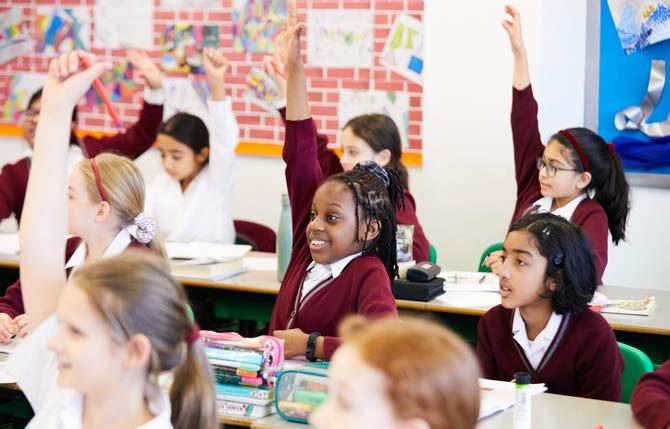
“We can do some great work in schools, but then they get out into the workplace and there is still a lot of prejudice and stereotyping. My older daughter’s a doctor; she’s constantly being called a nurse. My younger daughter is one of only two girls in her university class taking aerospace engineering. So, the challenge is twofold—not only getting girls to take these subjects but to stay in them for their careers.”
– Caroline Hulme-McKibbin, Head, Kensington Prep School GDST
“Teachers traditionally will judge themselves on the basis of what marks their students are getting because that’s their yardstick. The scorecard is not what the outcome for that child will be through their career. I think we need to reframe that, where we say this isn’t necessarily about helping girls do better at school. It’s helping girls do better through life.”
– Rishi Khosla OBE, Founder and CEO, OakNorth Bank
One of the ways that the GDST seeks to challenge stereotypes and lay firm foundations for a lifelong appreciation and engagement with STEM is through the GDST Space Technology Diploma, which is delivered across multiple GDST Sixth Form departments. It is
designed to develop coders for computer science-based space technology ventures using the Python Programming language. Through the diploma, computer science-specific skills are purposefully honed for the space industry, focusing on the abilities desired for industry-
level internship experiences. In 2023, the programme received a Royal Society STEM Partnership Grant (collaborating with Cambridge University and NASA) and an AWS Proof of Concept investment to investigate aerial image and sensor data collection from remote airborne devices.
Financial Literacy & Entrepreneurial Intention
Our Girls’ Futures Report revealed that just one-third of girls felt prepared for the future by age 18, only 11% of girls felt that school prepared them with financial skills and 10% on different ways to earn money. Yet 70% of respondents said that financial literacy was a key skill they wanted to gain from school.22
Reflecting the sentiment of these findings, Charlotte Keenan, Head of the Office of Corporate Engagement International at Goldman Sachs, suggests that mathematics and economic education need to go further and put an increased focus on day-to-day money management: “People are leaving school, they’ve got GCSE maths, but can they compute that into what that means in terms of an interest rate on a credit card? Do they understand effective savings plans, tax structures and basic budgeting? All of that is very important.”
“The idea of freedom of choice and empowerment for women is impossible without a financial foundation,” according to MoneyShe founder Gina Miller, writing for our 2022 Girls’ Futures
Report 23 “The impact of this is that we have a gender pay and savings gap that will take hundreds of years to close. Women are living longer, and the practical effect of that is more women living in poverty in old age; without financial education, your future self is in danger of living in poverty, to the tune of four times that of men.”
Paul Marshallsay, Headmaster of Portsmouth High Prep School GDST, is currently developing a financial education course for his pupils, which is part of a programme being developed by the GDST in response to the findings of the Girls’ Futures Report, which begins with a unit of work on budgeting. He recognises the need to teach financial literacy from a young age: “In a world where cash is used less and less, younger children are developing the idea that there is a magic card or phone that can get them what they desire. We aim to help our girls be more aware of money in a numerical sense, thereby understanding the relationship between that and the things they have around them. Crucial to this approach is the difference
between wants and needs and the ability to understand and plan personal budgets. This is all delivered in a fun and engaging way that allows the children to explore the concepts whilst planning exciting events and projects. These are the first steps towards having a responsible and independent approach to financial education.”
In addition to having financial skills, it is vital to encourage girls’ entrepreneurial mindset. One of the ways we do this, is through GDST LEAD—Leadership Enterprise Advanced Diploma— a programme designed, developed and delivered in partnership with the London School of Economics and Political Science. It seeks to enable our young women to learn about key elements of mentorship and entrepreneurship whilst developing their leadership skills. GDST LEAD has evolved into an exemplar of how young women can be prepared for a future in which they do not just survive but thrive.

“The idea of freedom of choice and empowerment for women is impossible without a financial foundation.”
– Gina Miller, Founder, MoneyShe
The programme teaches our students about the ever-evolving world of work and equips them with the essential skills to navigate a life of careers rather than a job for life. It provides them with first-hand experience
in founding a sustainable business. Importantly, LEAD students also learn about navigating workplace issues such as managing unconscious bias and how to negotiate a pay rise or shared parental leave.
One Sixth Form student on the LEAD programme in 2023 commented that it had “been the single most impactful activity” she had been involved in during her time at school.
Redefining Leadership & Going Beyond the Curriculum
While gender equality in the workplace has improved over the last few decades, there is still room for significant progress regarding women occupying leadership positions. LinkedIn data in the new Global Gender Gap Report 2023 showed that the hiring rate of women in leadership roles has stalled, and, in some sectors, hard-
won progress is now being reversed.24 Even more worryingly, a March 2024 poll from Verian and Reykjavík Global revealed that people in G7 countries are becoming increasingly ‘prejudiced’ against women in leadership positions, with the decline being especially pronounced amongst young people.25 These figures cast
doubt on the long-held assumption that it is only a matter of time before gender parity at a leadership level is achieved. They also give a sense of urgency to the need to provide school-aged girls with the right conditions and opportunities to develop their leadership skills and experiences.
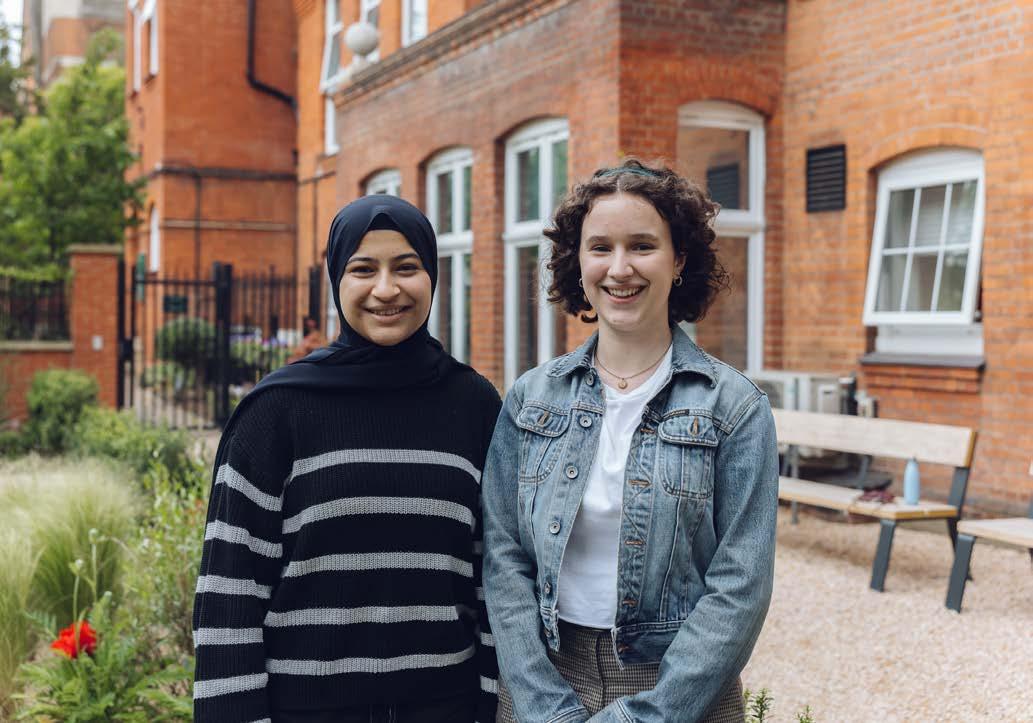
A sixth form student joined Nottingham Girls’ High School GDST from a co-ed school at sixth form and says that she has felt a lot more encouraged to join extra-curricular activity since moving school:
“We are constantly being emailed about new opportunities to get involved in. It means the school can focus on us more holistically and help us become more well-rounded because it isn’t just about our academic grades, it’s about how we develop as a person too.”
A sixth form student shares her personal experience in a co-ed school:
“I have always been sporty and love both cricket and netball. I never felt uncomfortable playing netball because it is considered a ‘girls’ sport’. Meanwhile, with cricket, there was no girls’ team, so the few girls who played had to be on the boys’ team and we received a lot of mocking. Now, though, cricket is huge at my girls’ school and I feel I can show my true ability. Before, I felt like I had to dumb down how good I actually was!”
Everyone would benefit from being empowered to challenge and redefine current leadership models. With changing perceptions of who and what makes a great leader, there is an opportunity for schools—singlesex and co-ed alike—to approach the notion of leadership differently. Our previous research demonstrated that while girls hold strong ambitions and passions about what they want to achieve, they do not necessarily want to lead in a traditional ‘from the front’ way. Instead, they value more collaborative and open leadership traits.26
Dr Marissa Porges—an ex-US Navy pilot, former National Security Adviser in Barack
Obama’s White House, and former principal of a girls’ school in Philadelphia—supports the case for redefining ‘leadership’ to avoid the implication that we want girls to be more like boys. In her book, What Girls Need, she argues that we should encourage girls to stand up for themselves and ask for what they need and want, to realise that competition can be a healthy endeavour, and not belittle their own skills for fear of upsetting others; they should be encouraged to use and expand their natural collaborative problem-solving abilities and be aware of the value of empathy; and they must be able to adapt to a wide variety of rapidly changing circumstances.27
Conversations for this report affirmed our long-held belief that the co-curriculum can provide a useful platform for developing these and other leadership skills. “You can develop a [extracurricular] club about any interest you have,” says Dr Elizabeth Hicks at GALA. “It means not only every leadership position is held by a girl, but that every girl in the school can be a leader. All they need to do is start a club and put in a structure.”
At Aylesbury High School, there are currently more than 100 such clubs, and there is an expectation that every student will take part in at least one.
9/ 10
“We monitor that to make sure that they are all accessing the co-curriculum,” says Marieke Forster, the school’s Headteacher, highlighting the diverse nature of activities, including Crochet Club, Frisbee Club and Debate Club. “We underpin everything with a very strong house system, which is student-led. In fact, we recently audited our student leadership opportunities and found that for our more than 1300 students, we have over 700 leadership positions. This allows us to deliver on building girls’ confidence, strength and independence.”
students at GDST schools agreed or strongly agreed with the statement ‘I feel like I belong at my school’.
We know from experience that co-curricular activities built around diversity and inclusion, such as culture and heritage clubs, pride groups and multi-faith societies, are especially important in developing students’ leadership
skills. Similarly, the presence of sports in developing these and other skills should also not be underestimated. Therefore, opening up as many opportunities for girls to explore sports, free from any expectations placed on their gender, is paramount.
For Hannah Morrell, Director of Sport at Blackheath High School GDST and Trust Consultant Teacher for Sport, there are “no girls’ sports, only sport to be played by all. It is so beneficial for girls to have the opportunity to participate and excel. Sports can and should be about the enjoyment of exercise and then the opportunity to add competition, participation and leadership at a high level comes with it. Our focus is on the girl, and the holistic benefits sport can bring to their lives.”
“There are no girls’ sports, only sport to be played by all. It is so beneficial for girls to have the opportunity to participate and excel.”
– Hannah Morrell, Director of Sport, Blackheath High School GDST and Trust Consultant Teacher for Sport
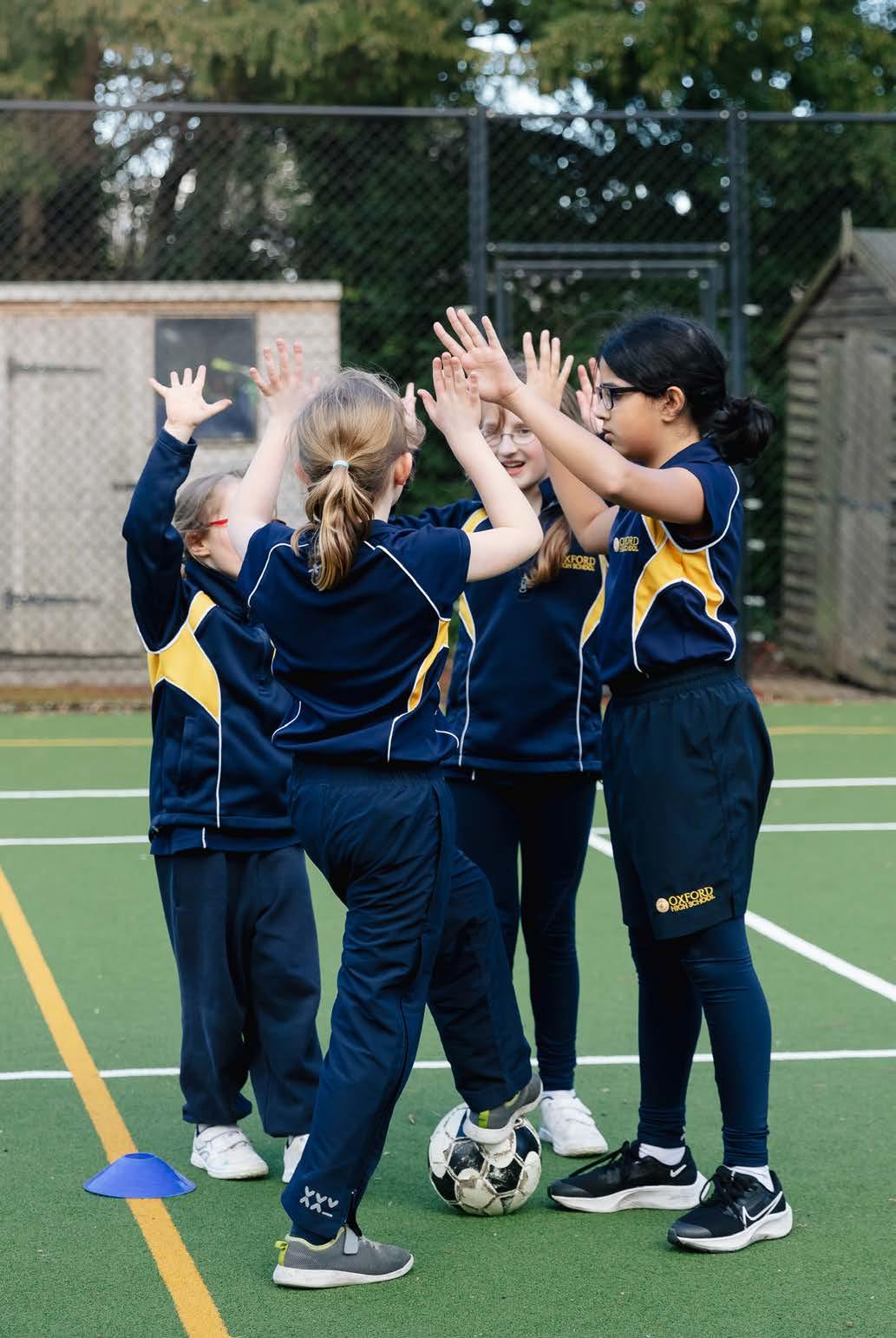
Culture
The importance of forming an unwavering girl-focussed mission acts as a springboard for the final principle, which is shaped around how school culture can be used to deliver better outcomes for girls. We find it important to discuss openly the challenges girls will face in their lives and careers. Our contributors also discuss the importance of finding internal and external role models for girls. In doing so, we place particular emphasis on teachers as role models.
A Mission for Girls
A clear pattern emerged when speaking to contributors: the importance of a culture that empowers and values individuals. The International Coalition of Girls’ Schools (ICGS) Global Executive Director, Megan Murphy says: “The minute a girl leaves school, she is living in a co-ed world, but that does not mean that being in a single-sex environment keeps them in a bubble. I think for a girl to be a young woman, interacting at her best in a co-ed world, then a girls’ school is where she’s going to hone her voice, where she will understand how to stand up and speak up.”
Head of Sheffield High School for Girls, Nina Gunson expands: “Everywhere they go outside school, girls are in a co-ed world. We’re carving out time and space each day where they’re forming their values, developing their voice, finding their own ideas, testing and challenging them in an unstifled way that takes gender inequalities out of the equation.”
While girls’ schools create an environment and space where gender inequality is absent, they also offer a space to be more open in having conversations about the challenges women will face in their personal and
professional lives.28 “We don’t want to overwhelm girls by telling them about all of the world’s issues and trying to make them feel they are responsible for being the change,” says Gunson. “Yes, they will come up against gender barriers [amongst others] and should be aware of that. But the best way that we can equip them is by providing transferable skills, knowledge and values while sharing with them the stories of successful women that will drive their aspirations.”
Gunson acknowledges it is important to speak candidly about women’s health and family planning in particular.
“We have to be open and honest that it is a juggling act, and when they choose to have a family, it needs to be factored into their career planning.”
“Men only have one decision. And that is, what career do I want to go into?” adds Female Lead Founder, Edwina Dunn OBE. “For women, there are two decisions: What career do I want to go into and to what extent will my career choice impact my ability to have a family, or vice versa?”
“All we want to do is lay out to our students what their lives may look like and to make the best decision for themselves. We would never tell them that either
a career or a family must come first,” Nina Gunson adds. “We don’t measure success by how many of our alumnae go into C-suite roles. It is important that girls define what success looks like for themselves, not on terms defined by men. Our role is to empower them and give them the entitlement to feel they can do whatever subject or career they want and that they should be judged on their own merit rather than their gender.”
Such candid discussions can only operate in an environment where girls have a strong sense of belonging. The GDST Student annual Undivided
Survey measures a ‘belonging score’ for students between Year 5 [age 9-10] and Year 13 [age 17-18], identifying that a sense of belonging drives high performance, innovation and candour in the classroom. Nine in 10 students at GDST schools agreed or strongly agreed with the statement ‘I feel like I belong at my school’.
“It’s a way to ascertain how particular groups might be feeling in schools so that we know where we need to focus our efforts,” explains Claire Bale, Head of Diversity and Inclusion at the GDST.
“It is very important to me that we listen to students, that they are able to express themselves and their views, that they’re not judged because of how they wear their hair, by their sexuality, by what they read, by the sports they play. While a level of discipline and rules is always necessary, we do not agree with controlling models of behaviour management because while education is in part about academic outcomes, it’s also about relationshipbuilding, understanding how to express yourself and being part of a community.”
– Julie Taylor, Principal, The Belvedere Academy GDST
“One of the things that has made me really proud is that Ofsted said in its last review that our young people are being young people. They’re not robotic. It’s not an exam factory. And they are loving life in school. The outcome is that girls’ experience of school sets them up for life outside those gates.”
– Marieke Forster, Headteacher, Aylesbury High School
Female Role Models in School
In a girls-only school, girls represent every single leadership position in the student body.
From Head Girl, to prefects, to the captain of the maths team or the football team and beyond, there is no question: women can hold any position they want.
“You’re never put into second place by a boy in the school context,” says former Olympic rower, Cath Bishop.
Megan Murphy emphasises the importance of the presence of internal role models: “Girls take centre stage in a way they do not in co-ed environments. At girls’ schools, a girl occupies every single seat in student government. The advanced computing science courses, the advanced maths and physics courses, and every single seat in those classrooms at a girls’
school are filled by a girl. That is so incredibly powerful.”
This is not to say that female role models are not important in co-ed environments; they are. Indeed, it is incumbent on co-ed schools to ensure they are doing all they can to celebrate female role models in any aspect of school life as this will help to redress the authority imbalance discussed earlier in this paper.
The power of the internal role model is evident at Croydon High School GDST as Head Annabel Davies identifies: “Aspiration is achieved through inspiration and the power of a role model at Croydon High School. Our ‘Big Sister Little Sister programme’ in the Senior School and our ‘Reception and Year 6 buddy programme’ in the Junior School demonstrates the essence of this
belief through mentorship and guidance but also through fun and friendship. One of our Year 8 [age 12-13] students said, ‘You look up to the older girls and see all the amazing things they are achieving and think to yourself that in a few years, that could be you’”.
We should not forget that educators are powerful role models for their students.
Dr Jessica Wade is a former South Hampstead High School GDST student and is now a Royal Society University Research Fellow and Lecturer at Imperial College. She says: “I think that teachers being passionate about what they teach greatly impacted me and my decision to become a physicist. I hear it so often that people learn physics from people who aren’t specialists in
“At girls’ schools, a girl occupies every single seat in student government […] That is so incredibly powerful.”
– Megan Murphy, Global Executive Director, ICGS
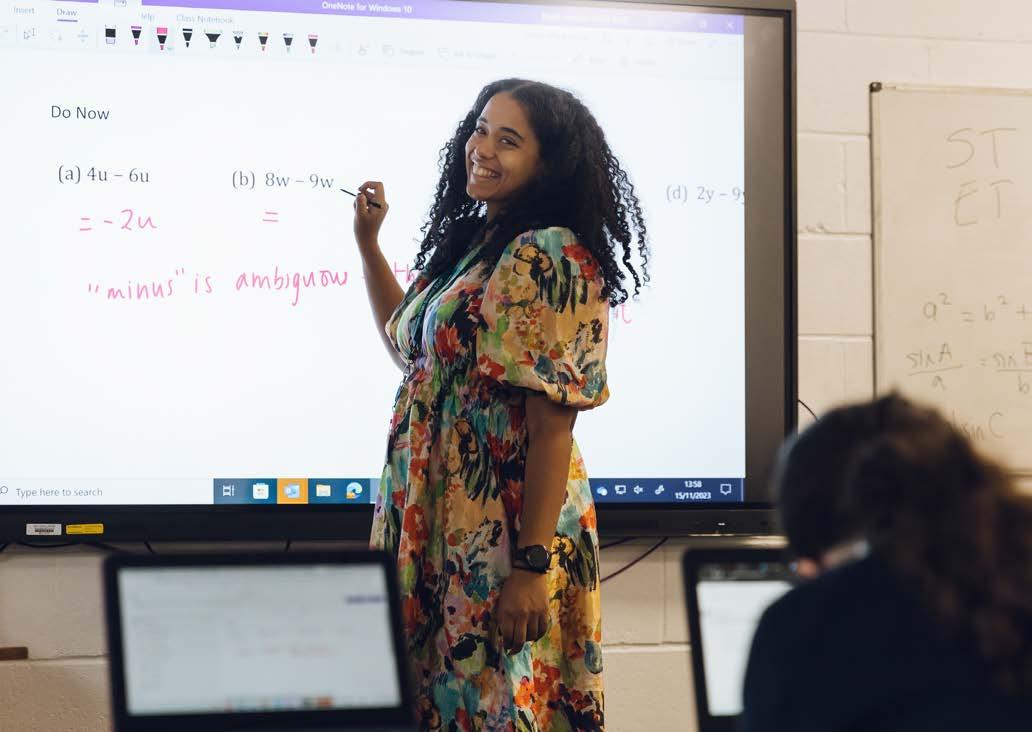
the subject, whereas my physics teacher at South Hampstead had a PhD in materials physics. It meant she was able to take the subject beyond the curriculum.”
Headteacher of Aylesbury High School, Marieke Forster, adds: “I am incredibly proud of all of my staff, both teaching and non-teaching. However, I think making sure that we are able to put teachers in front of classes who walk tall and feel really proud of what they do and are valued by society is a really good challenge.”
Teachers must be motivated to be the best role models they can
be. Indeed, a UNESCO study found that one of the tenets of providing a quality education is teacher motivation.29 The source of this motivation and the type of role model they are to students are numerous.
For Debbie Hill, Teacher of Modern Foreign Languages at Northampton High School GDST and Trust Consultant Teacher for Research, motivation comes through the intellectual stimulation of facilitating collaborative research-informed practice. “Reflective practice lies at the heart of exceptional teaching; we constantly ask ourselves: Does this strategy
work? Has it had an impact? How do we know? Engaging with academic research, reading widely, and having opportunities to reflect on and discuss ideas and their practical application with colleagues can help us answer these questions.”
Hill’s important role in promoting and supporting research as a collaborative endeavour, providing exceptional professional learning while connecting teachers across the GDST school network, benefits students’ and teachers’ intellectual wellbeing.
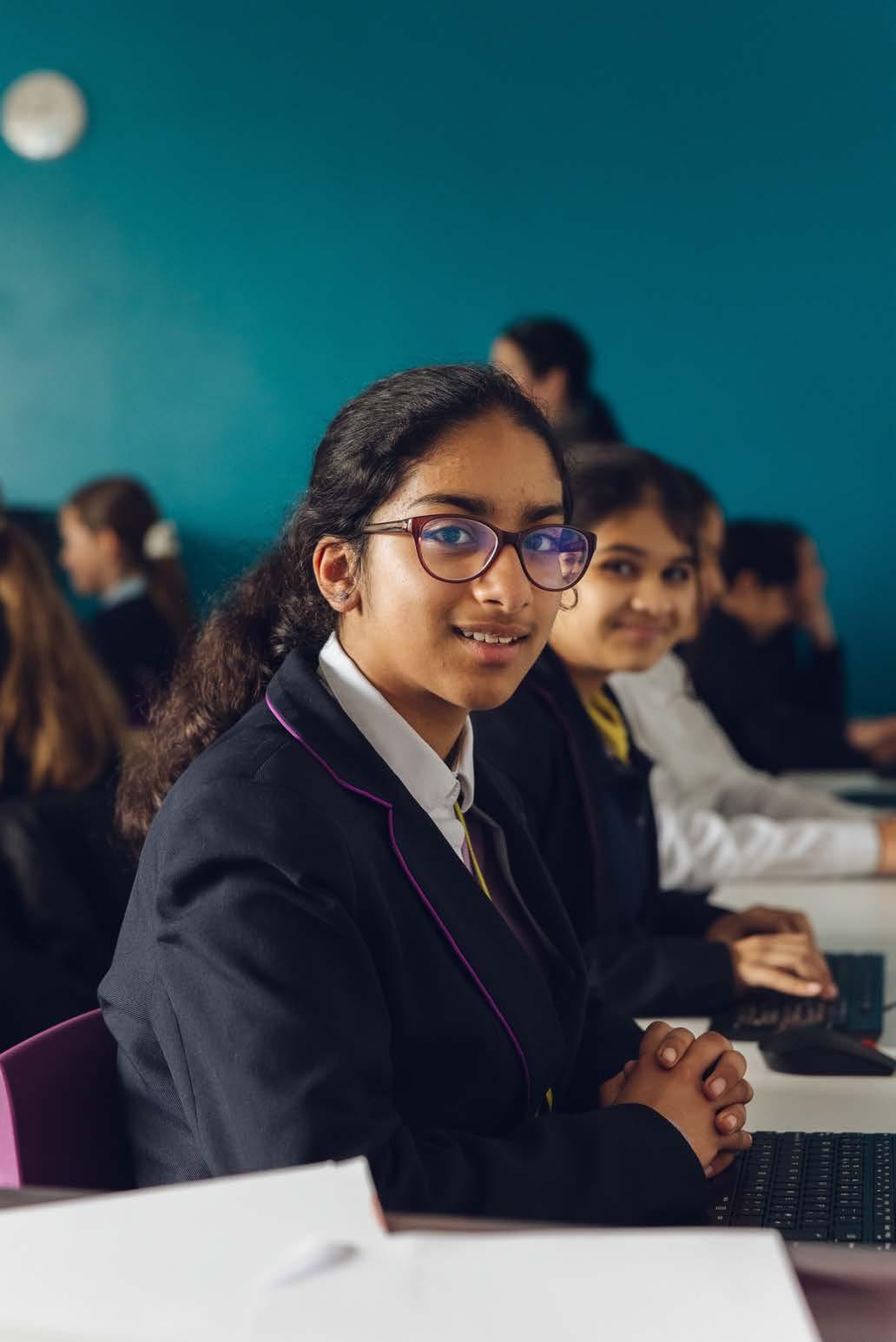
We are also ensuring that our teachers are role-modelling active engagement with their craft via the Global Action Research Collaborative (GARC) on Girls’ Education, which is part of the offering from the International Coalition of Girls’ Schools. One recent 2024 cohort participant mentioned that this initiative had “reinvigorated their interest in pedagogy, which had waned a little since teacher training. I am much more enthusiastic about trying new approaches, imbued with the confidence in research design and execution that the GARC programme gave me.”
According to Jake Unwin, Head of History at Sutton High School GDST and Trust Consultant Teacher for the Humanities, the collaborative networks of groups of schools, such as the GDST, can help teachers strive for improvements in how they teach to the benefit of students at our
schools while role modelling the collaborative spirit we want from them: “One of the great privileges of working within the GDST is that within each subject specialism, the 25 schools’ Heads of Department alone have a cumulative average of 250 years’ worth of experience teaching girls their subject. Collaborating within that team means students benefit from teachers who are challenged, inspired, supported and motivated by a rich community of experts. This means students benefit from the best evidence-based teaching practice developed across the Trust’s schools.”
Claire Bale, Head of Diversity and Inclusion at the GDST, explains the importance that the organisation places on positive role modelling.
“Having teachers and older students who demonstrate that girls can become experts in any subject they choose, and
of GDST students agree with the statement, ‘I have positive role models in school.’
who exemplify a diverse range of identities, is crucial to the student experience and nurturing high aspirations. Through our annual student survey, we monitor how many students agree with the statement, ‘I have positive role models in school’, which was 87%.” 87%
“Having teachers and older students who demonstrate that girls can become experts in any subject they choose[...] who exemplify a diverse range of identities, is crucial to the student experience and nurturing high aspirations.”
– Claire Bale, Head of Diversity and Inclusion, GDST
Female Role Models Outside of School
At Portsmouth High School GDST, Head of Careers Sammy Davies has led an initiative called ‘Girls Like You’, bringing successful alumnae back to the school to speak about diverse careers. Speakers at the 2023 event during National Careers Week included a trainee solicitor, a pilot, a music supervisor and a meteorologist. Another, Evie Chandler, who holds a role in commercial events with the English Football League, shared how she has overcome perceptions and barriers in a male-dominated environment.
GALA Founder Dr Hicks tells us that bringing role models into the school is central to her mission. “We look at how we can help girls to combat the sense that they might not belong somewhere. And so, we talk pretty openly, especially in 11th and 12th grade [age 1618], about how they can be in unfamiliar environments when they go to college, where they may be one of the only women in their class – particularly if they are a woman of colour. Are there people on staff that
you can connect with? Are there organisations you can connect with?”
Of course, it should be acknowledged that girls’ schools, particularly in the independent sector, have far more extensive alumnae networks to draw on than the majority of co-ed state schools, which is why physicist and GDST alumna Dr Jessica Wade is among the voices who stress the importance of girls’ schools partnering with co-ed schools in their communities to leverage their women networks.

Another access point to role models for schools without extensive alumnae networks is working with external businesses and social enterprises, such as Founders4Schools. Serial entrepreneur Sherry Coutu CBE, its Chair and Co-Founder, says: “We make it much easier for teachers to illustrate a point in the curriculum by showing realworld examples. Not by talking about a TV show, but by referring to somebody they brought into the classroom, even if it’s just for half an hour.”
Furthermore, Maths4Girls, a campaign from Founders4Schools, allows educators to invite female (and male) role models who work within maths-based sectors such as finance, computing and STEM into the classroom to inspire and encourage students to take maths beyond GCSE. Coutu adds: “People who run their own businesses in our communities perform a crucial role that we shouldn’t miss out on. Teaching about the importance of Ada Lovelace is one thing, but to a girl in Birmingham today, for instance, Ada Lovelace seems a million miles away. But to a girl from the same [geographical] community, a woman running a fintech company in Birmingham who’s only ten years older—that starts to look really interesting.”
Schools should also encourage their students to cultivate a more
diverse range of role models online. Edwina Dunn OBE is the founder and CEO of The Female Lead—a communityled movement with a mission to empower women and girls by breaking the societal cycle of gender roles. Its early objective was to provide schools with inspiring role models, making women in high-achieving roles visible to young people. But in recent years, it has adapted its approach to go further— recognising the often-harmful influence of social media algorithms on girls’ perceptions of themselves and what it means to be successful.
Dunn says: “What we hadn’t anticipated when we started out is the sheer force of social media. It’s an addiction. And
the problem is that it gives young people, particularly girls, a sense of something that is not realistic. It’s staged, it’s engineered. It gives girls the sense they have to perform to a level of what’s considered beautiful, funny or clever. It conditions perfectionism.” To counterbalance this, The Female Lead now campaigns for girls to “disrupt their feed” by following just a few “real people” [i.e. not just celebrities].
“We have found that when they do this, there is a seismic change in their behaviour and their confidence. If you can get girls to start realising that they need to control the algorithm, not the algorithm controls them, that’s when we begin to see a positive impact.”
“People who run their own businesses in our communities perform a crucial role that we shouldn’t miss out on.”
– Sherry Coutu CBE, Chair & Co-Founder, Founders4Schools
Conclusion
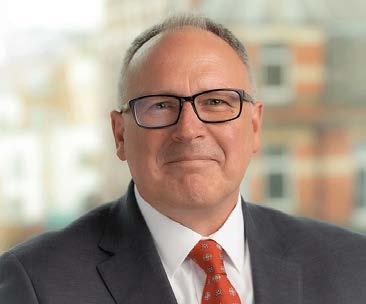
Dr Kevin Stannard, Director of Innovation & Learning
at the Girls’ Day School Trust
It is sometimes suggested that since the world is co-ed, young women who have attended all-girls schools will be at a disadvantage when they encounter young men at university and beyond. The research says precisely the opposite, but the best responses are from alumnae who explain (as patiently as is polite) how girls-only settings helped them have a basis for engaging with anyone not just males.
Girls in schools need to learn the skills necessary to navigate a world still characterised by structural inequalities and personal prejudices. Beyond academic success, the life lessons they need to learn include figuring out how to challenge and influence authority, how to improvise as well as prepare, finding effective forms of self-promotion, welcoming a less-prescribed career path, and going for being respected, not just liked.30
This GDST Insights Report has explored some of the many ways in which such outcomes are achieved in all-girls settings through classroom practice, curricular and co-curricular design, and school culture. It proves the point that today’s girls’ schools exist to prepare girls for, and not to protect them from, the ‘real’ world.
But let’s be clear: ‘merely’ separating girls from boys is a necessary but not a sufficient condition for success. This much is evident in the results of some experiments with the ‘diamond’ model in schools that separate the sexes for some lessons in some phases. Little is achieved if the standard teaching model is unchanged, prevailing attitudes are unchallenged and the wider school culture stands still.
Where does this leave the majority of girls who attend co-ed schools? We argue that they need— and deserve—advocates and allies who encourage school leaders and educators to reflect on their practice and how they can challenge and alter some of the structures and mindsets that shortchange female pupils.
NEXT STEPS
The insights we have gathered demonstrate that girls’ schools are a vital pillar of society and have a significant role to play in closing the gender pay and authority gaps. Far from being quaint or quirky educational outliers, they are a necessary and indispensable part of the modern educational landscape.
What works in girls’ schools could be applied in co-ed settings. The tools available to schools and teachers who want to empower girls are not impossible to put into practice. The problem is that it becomes more difficult to do so because so often other imperatives intervene—not least the need to keep boys engaged.
And as long as the girls are doing OK (or better) in exams, ensuring that girls are learning without limits seems less like a burning platform.
Unfortunately, the result, not always but too often, is that girls conform outwardly and lapse into gender stereotypes that limit their horizons and affect their lives in moral and material ways.
In researching this report, we spoke with a large group of contributors, each of whom took significant time to provide us with detailed and considered views on the questions asked of them.
Much of what they told us could not be included in this paper,
so we want to continue sharing insights from these discussions, furthering the conversation.
We also want to celebrate the significant part that teachers play in ensuring girls’ successes. In speaking to them for this paper, we have found that they prioritise values above all, ensuring that their students emerge as wellrounded human beings, not only driven by academic success.
But in addition to amplifying these insights to raise awareness, we aim to harness them in practical ways that spark action.
“Girls in schools need to learn the skills necessary to navigate a world still characterised by structural inequalities and personal prejudices.”
– Dr Kevin Stannard, Director of Innovation and Learning, GDST
Designing the Future of Girls’ Education Framework
It is an uncomfortable truth that gender equality is far from the norm in schools today. To accelerate the pace of change, the GDST has developed an evaluation framework under a series of headings distilled from the themes arising from this GDST Insights Report.
HOW TO USE THE FRAMEWORK?
The headline themes are categorised into stages of development: emerging, developing and transformational. This scaling of progress is designed to help schools and practitioners audit and develop their approach to girls’ educational and personal development through reflection, selfevaluation, and strategic development plans.
This framework can be used in its entirety or broken down into its component parts of classroom, curriculum, and culture.
WHO SHOULD USE THE FRAMEWORK?
The framework has been designed for individual teachers and senior school leaders at all levels, as we believe that the whole school community has a role to play in delivering gender equality.
We recommend that this framework is used by girls’ and co-ed schools alike. However, we believe it is incumbent on co-ed schools, in particular, to demonstrate to themselves and others, that they are meeting the needs of all their pupils equally. Where senior school staff believe their school to be performing well, we invite them to seek student and staff voice using the framework.
In addition, we invite families to use it when making important decisions about which school or setting will best enable their daughters to discover their passions, reach their academic potential and thrive in the future.
THE GDST – A LEADER IN GIRLS’ EDUCATION
As a global voice on the design and delivery of world class girls’ education, Designing the Future of Girls’ Education, a GDST Insights Report is part of our latest series of innovative research, supporting the specific needs of girls, in all learning environments. The education of girls was central to the founding of GDST schools over 150 years ago, and it remains at the heart of our modern-day mission.
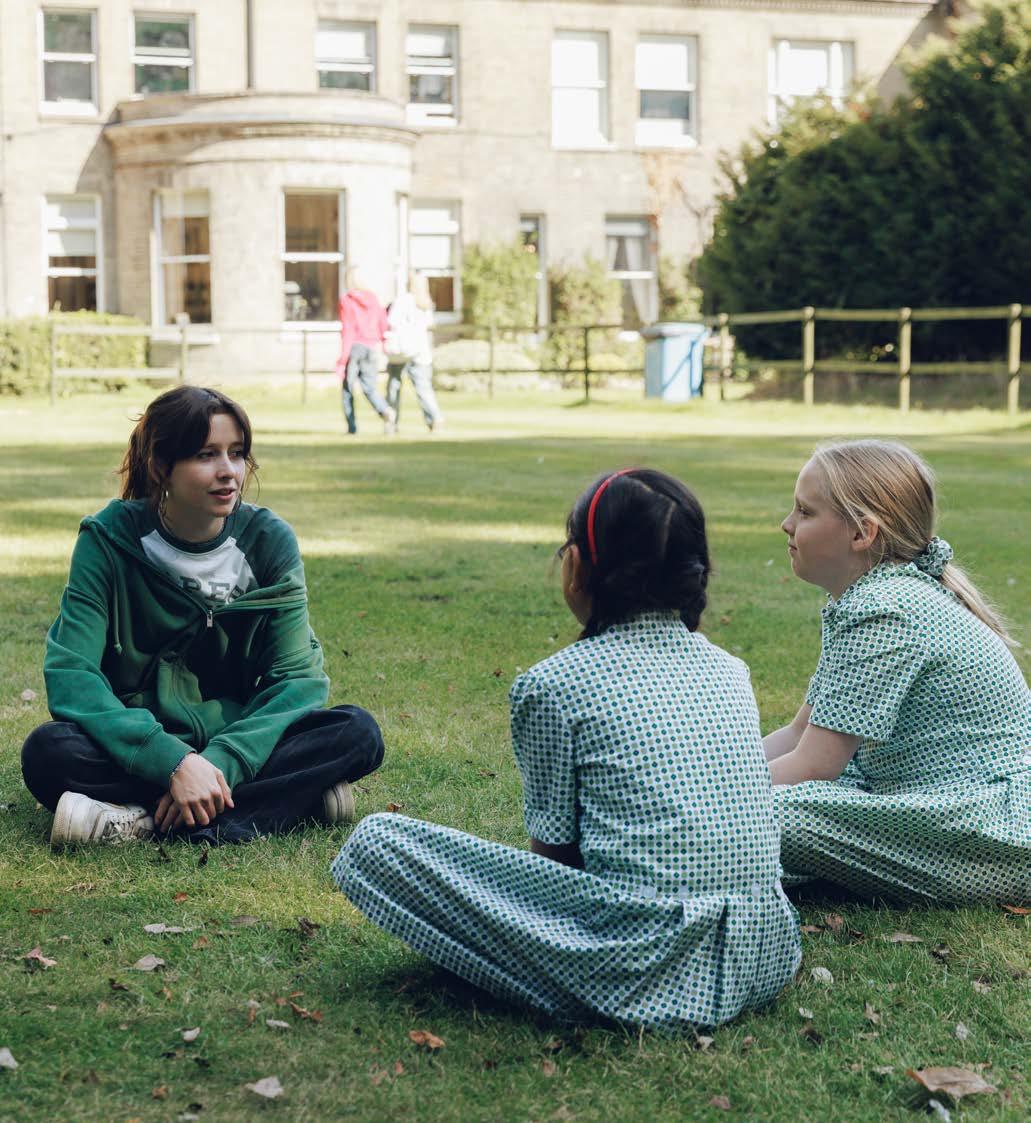
JOIN US ON THIS JOURNEY
The framework presents the opportunity for educators to share progress and best practice with a wider audience. We look forward to sharing these achievements over the coming months and years to accelerate the pace of change across the education sector. We will continue to work openly and collaboratively with our partners to demonstrate that progress towards a gender equal society is optimised by schools when classroom practice, curriculum and culture are transformed to meet the needs of girls.
gdstinsightsreport@wes.gdst.net
Classroom Practice
Empower girls to be successful on their own terms and in their own voice.
Cultivate the dispositions that enable girls to engage with boys on equal terms.
Girls are encouraged to be confident in speaking up for themselves.
Girls are taught to be confident and successful in a way which is authentic to them.
Girls are given equal ‘airtime’ in class and are not subject to different behavioural expectations.
Celebrate risk taking and normalise failure.
Curriculum & Co-Curriculum
Challenge subject and career-based gender imbalances
Build financial literacy and entrepreneurship
Promote inclusion in sport and physical exercise (PE)
Girls are encouraged and taught to speak up, speak out, and to actively subvert unhelpful stereotypes.
Girls are supported in how to respond when their opinions are questioned, and they are subject to interruption, or not taken seriously.
Girls are taught how to learn from failure.
Girls (and boys) are taught about gender stereotypes around STEM subjects.
Girls are provided with the financial understanding and competencies they will need in the future.
Girls’ biases, stereotypes, and perceptions around their participation in PE and sport are acknowledged.
Girls are encouraged to take up leadership positions across the curriculum and co-curriculum.
DEVELOPING
DEVELOPING
Girls are taught explicitly how to resist perfectionist tendencies which might limit their progress.
Obstacles to participation and take-up in particular subject areas and interests are identified and addressed. Every opportunity is given to girls to express their enjoyment and passion in these subjects.
Girls are encouraged to develop an entrepreneurial mindset that includes an understanding of risk management and the necessary leadership and teamwork skills.
Challenges to girls’ full and equal participation in PE and sport are identified and addressed through teachers’ promotion of a breadth of sports and their lifelong health benefits.
Girls actively participate in leadership positions across the curriculum and co-curriculum. DEVELOPING Increase opportunities for girls to take on leadership roles
Girls are empowered to engage with opposing views with respect and confidence.
Girls are encouraged to try things out, to resist perfectionism, and to embrace error as a heuristic learning process.
Gender stereotypes around STEM subjects are actively dismantled by teachers. Girls are well-represented in non-compulsory STEM courses.
Girls are provided with the financial and entrepreneurial skills, knowledge and mindset that will underpin their future influence and independence as women in society.
Girls’ physical/sporting engagement and achievements are given equal status in terms of investment, staffing, expertise, facilities and recognition. Girls take on leadership in sports at all levels.
Gendered tropes of leadership are actively challenged and diverse authentic leadership styles are encouraged.
Culture
Openly discuss barriers to equality
EMERGING
School culture recognises the barriers that remain to equality for girls and women.
DEVELOPING
Girls recognise gender inequalities, in terms of women’s influence, autonomy and the pressure on women Girls are not made to feel responsible for these inequalities, but they understand the societal contexts for them.
Create an inclusive culture Exemplify a narrative of female achievement
Celebrate and develop teachers and others who actively inspire female students
TRANSFORMATIONAL
There is open discussion and recognition, by all pupils, of the challenges that girls will face in their private and professional lives.
Girls feel they belong in a school culture of openness and inclusion.
DEVELOPING
Girls of all different intersectionalities feel they belong in a school culture of openness and inclusion.
TRANSFORMATIONAL
Girls of all different intersectionalities feel they belong in a school culture of openness and inclusion, and this belonging is retained in environments or situations that they are unfamiliar with or may be challenged by. EMERGING
The limits that girls sometimes place on their aspirations are acknowledged by their teachers.
DEVELOPING
The limits to girls’ selfefficacy are acknowledged by their teachers who provide access to a diverse range of women’s voices, stories and achievements.
Girls are inspired by those that teach them and otherwise interact with them.
DEVELOPING
Girls are inspired by examples of women in traditionally underrepresented subjects and sectors.
TRANSFORMATIONAL
Girls are actively encouraged by their teachers to resist putting gendered limits on their aspirations through a culture of celebrating female achievement of all forms. EMERGING
TRANSFORMATIONAL
Girls are connected to role models inside and outside of school, including the alumna network, and provided with networking and mentoring opportunities.
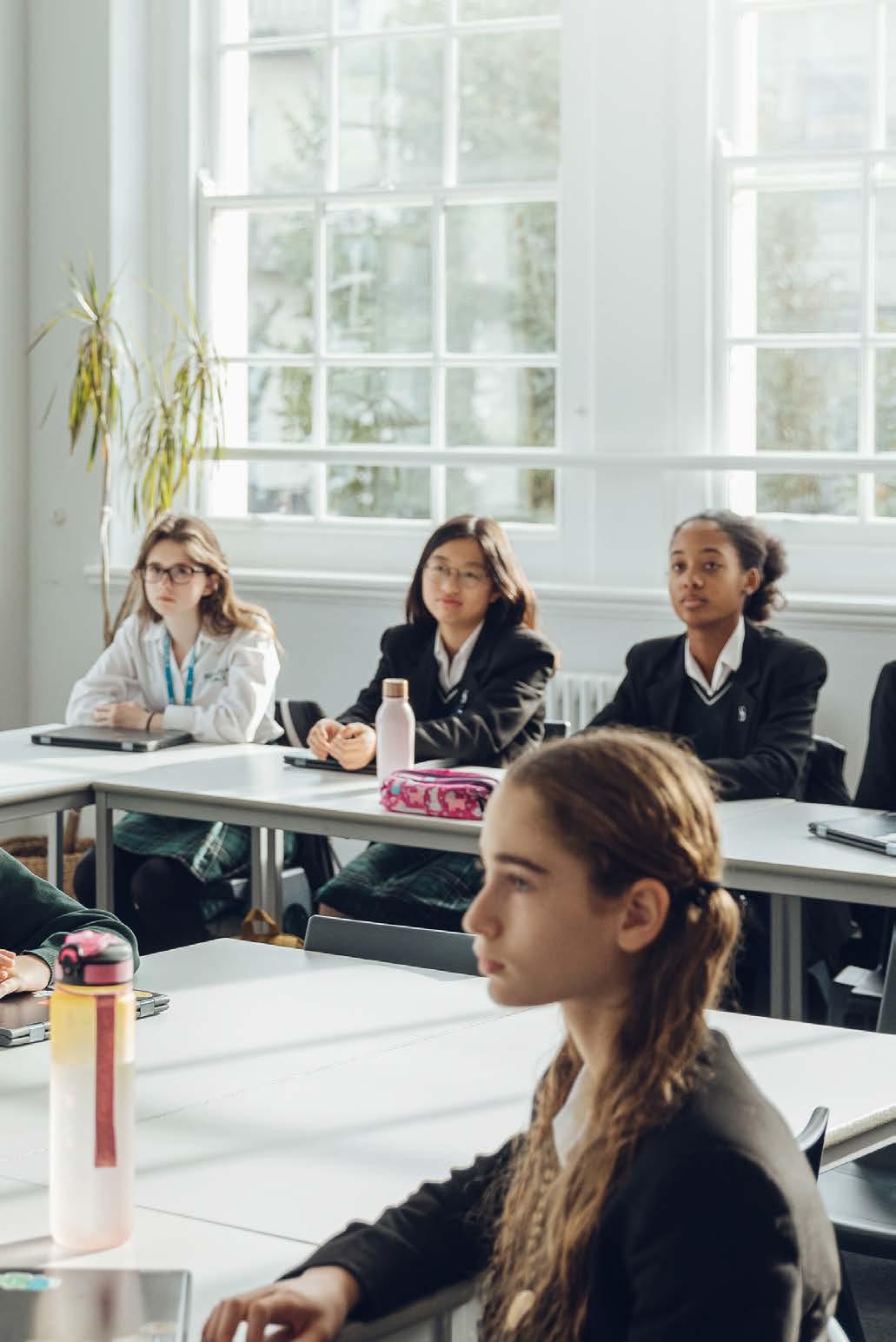
Endnotes
1 Whilst we refer to ‘girls’ and ‘girls’ schools’ in the Insights Report, we recognise that students identify in a number of ways. We acknowledge the ongoing discussion around gender identity; indeed, all voices need to be heard and involved as we discuss the needs and desires of the next generation of young people to shape the workplace and wider society.
2 The United Nations (2022) ‘Achieving full gender equality is still centuries away, warns the UN in new report’, The United Nations [Online]. Available at https://www.un.org/en/desa/achieving-fullgender-equality-still-centuriesaway-warns-un-new-report (Accessed 3 June 2024).
3 Younger, M. (2016) ‘Effective Pedagogies for Girls Learning: A review of recent research’, The Girls’ Day School Trust [Online]. Available at https://www.gdst. net/publications/effective-pedagogies-forgirls-learning/ (Accessed 3 June 2024).
4 The Girls’ Day School Trust (2022) ‘The Girls’ Futures Report: Shaping skills, driving confidence, and creating leaders’, The Girls’ Day School Trust [Online]. Available at https://www.gdst.net/wp-content/ uploads/2023/09/Girls-Futures-Researchupdated-01.08.23.pdf (Accessed 3 June 2024).
5 The Girls’ Day School Trust (2023) ‘The GDST Difference: Designing education for girls’ futures’, The Girls’ Day School Trust [Online]. Available at https://www.gdst.net/ about-us/the-gdst-difference/#downloadgdst-difference-booklet (Accessed 3 June 2024).
6 Stannard, K. (2024) ‘Why (and How) Girls Thrive in Girls-Only Schools’, The Girls’ Day School Trust [Online]. Available at https://www.gdst.net/publications/whyand-how-girls-thrive-in-girls-only-schools (Accessed 3 June 2024).
7 All students attended a GDST sixth form having previously attended a co-ed school up to GCSE.
8 Stannard, K. (2024) ‘Why (and How) Girls Thrive in Girls-Only Schools’, p. 43.
Further Reading
10 Stannard, K. (2024) ‘Why (and How) Girls Thrive in Girls-Only Schools’, p. 30.
11 The Girls’ Day School Trust (2022) ‘The Girls’ Futures Report’, pp. 26–37.
12 Orgad, S. and Gill, R. (2022) Confidence Culture, Durham, Duke University Press.
13 The Girls’ Day School Trust (2022) ‘The Girls’ Futures Report’, p. 14.
14 Harskamp, E., Ding, N. & Suhre, C. (2008) Group Composition and its Effect on Female and Male Problem-Solving in Science Education’, Educational Research vol. 50, no. 4, pp. 307–318.
15 The Girls’ Day School Trust (2022) ‘The Girls’ Futures Report’, p. 12.
16 University of Cambridge (2020) ‘The Oracy Skills Framework’, The University of Cambridge Faculty of Education [Online]. Available at https://www.educ.cam.ac.uk/ research/programmes/oracytoolkit/ oracyskillsframework/ (Accessed 3 June 2024).
17 Masterson, V. (2023) ‘Future of Jobs: These are the most in-demand skills in 2023 - and beyond’, The World Economic Forum [Online]. Available at https://www. weforum.org/agenda/2023/05/future-ofjobs-2023-skills/ (Accessed 3 June 2024).
18 Stannard, K. (2024) ‘Why (and How) Girls Thrive in Girls-Only Schools’, p. 44.
19 Lessenski, M. (2023) ‘The Media Literacy Index 2023: Measuring Vulnerability of Societies to Disinformation’, Open Society Institute Sofia [Online]. Available at https:// osis.bg/wp-content/uploads/2023/06/MLIreport-in-English-22.06.pdf (Accessed 3 June 2024).
20 The Institute of Physics (2018) ‘Why not Physics? A snapshot of girls’ uptake at A-level’, The Institute of Physics [Online]. Available at https://www.iop.org/sites/ default/files/2018-10/why-not-physics.pdf (Accessed 3 June 2024).
21 Sax, L., Arms, E., Woodruff, M., Riggers T. and Eagan, K. (2009) ‘Women Graduates of Single-Sex and Coeducational High
9 Jacobi, T. & Schweers, D. (2017) ‘Justice, Interrupted: The effect of gender, ideology and seniority at Supreme Court oral arguments’, Virginia Law Review, vol. 103, no. 7, pp. 1379–1496.
Schools: Differences in their Characteristics and the Transition to College’, The Sudikoff Family Institute for Education & New Media, UCLA Graduate School of Education & Information Studies [Online]. Available at https://www.heri. ucla.edu/PDFs/Sax_FINAL%20REPORT_ Sing_1F02B4.pdf (Accessed 3 June 2024).
22 The Girls’ Day School Trust (2022) ‘The Girls’ Futures Report’, p. 37.
23 The Girls’ Day School Trust (2022) ‘The Girls’ Futures Report’, p. 43.
24 Lara, S. (2023) ‘Years on, and women are still not fairly represented in leadership. Here’s what we need to do to bridge the gap’, LinkedIn Economic Graph [Online]. Available at https://economicgraph. linkedin.com/blog/years-on-and-womenare-still-not-fairly-represented-inleadership (Accessed 3 June 2024).
25 Verian (2024) ‘The Reykjavík Index for Leadership’, The Verian Group [Online]. Available at https://www. veriangroup.com/content-downloadform/the-reykjav%C3%ADk-index-forleadership-2024 (Accessed 3 June 2024).
26 The Girls’ Day School Trust (2022) ‘The Girls’ Futures Report’, pp. 14–15.
27 Porges, M. (2020) What Girls Need: How to raise bold, courageous and resilient girls, New York & London, Penguin.
28 We recognise the disproportionate pressure felt by girls in terms of their appearance, with particular pressures on intersectional elements of girls’ identities. This paper does not go into detail regarding this challenge at this time.
29 International Institute for Educational Planning, UNESCO (2021) ‘Teacher motivation and Learning Outcomes’, UNESCO [Online]. Available at https:// learningportal.iiep.unesco.org/en/ issue-briefs/improve-learning/teachermotivation-and-learning-outcomes (Accessed 3 June 2024).
30 Johnson, W. and Mohr, T. (2013) ‘Women Need to Realise Work Isn’t School’, Harvard Business Review [Online]. Available at https://hbr.org/2013/01/ women-need-to-realize-work-isnt-schol (Accessed 3 June 2024).
Arnold, S. and McAuliffe, K. (2021) ‘Children Show a Gender Gap in Negotiation’, Psychological Science, vol. 32, no.2, pp. 153–158.
Beaman, R., Wheldall, K. and Kemp, C. (2006) ‘Differential Teacher Attention to Boys in the Classroom’, Educational Review, vol. 58, no. 3, pp. 339–366.
Biddulph, S. (2019) Raising Girls in the Twenty-First Century, London, Thorsons.
Borg, E. (2015) ‘Classroom Behaviour and Academic Achievement: How classroom behaviour categories relate to gender and academic performance’, British Journal of Sociology of Education vol. 36, no.8, pp. 1127–1148.
Carey, T. (2015) Girls Uninterrupted: Steps for building stronger girls in a challenging world, London, Icon Books.
Cohen-Hatton, S. (2023) The Gender Bias: The barriers that hold women back, and how to break them London, Blink.
Cribb, V. and Haase, A. (2016) ‘Girls Feeling Good at School: School gender environment, internalization and awareness of socio-cultural attitudes associations with selfesteem in adolescent girls’, Journal of Adolescence, vol. 46, pp. 107–114.
Damour, L. (2019) Under Pressure: Confronting the Epidemic of Stress and Anxiety in Girls, London, Atlantic Books.
Donald, A. (2023) Not Just For The Boys: Why we need more women in science Oxford, Oxford University Press.
Garcia, M. (2021) We Are Not Born Submissive: How patriarchy shapes women’s lives, Princeton, NJ, Princeton University Press.
The Girls’ Day School Trust (2023) ‘The GDST Difference: Designing education for girls’ futures’, The Girls’ Day School Trust [Online]. Available at https:// www.gdst.net/about-us/the-gdstdifference/#download-gdst-differencebooklet (Accessed 3 June 2024).
The Girls’ Day School Trust (2022) ‘The Girls’ Futures Report: Shaping skills, driving confidence, and creating leaders’, The Girls’ Day School Trust [Online]. Available at https://www.gdst.net/ wp-content/uploads/2023/09/GirlsFutures-Research-updated-01.08.23.pdf (Accessed 3 June 2024).
Guthold, R., Willumsen, J. and Bull, F. (2022) ‘What is Driving Gender Inequalities in Physical Activity Among Adolescents?’ Journal of Sport and Health Science, vol. 11, no. 4, pp. 424–426.
The Institute of Physics (2018) ‘Why not Physics? A snapshot of girls’ uptake at A-level’, The Institute of Physics [Online]. Available at https://www.iop.org/sites/ default/files/2018-10/why-not-physics. pdf (Accessed 3 June 2024).
Jacobi, T. & Schweers, D. (2017) ‘Justice, Interrupted: The effect of gender, ideology and seniority at Supreme Court oral arguments’, Virginia Law Review, vol. 103, no. 7, pp. 1379–1496.
Jones, S. and Myhill, D. (2004) ‘Troublesome Boys and Compliant Girls: Gender identity and perceptions of achievement and underachievement’, British Journal of Sociology of Education vol. 25, no. 5, pp. 547–561.
Justman, M. and Mendez, S. (2018) ‘Gendered Choices of STEM Subjects for Matriculation are not Driven by Prior Differences in Mathematical Achievement’, Economics of Education Review, vol. 64, pp. 282–297.
Kuriloff, P., Andrus, S. and Jacobs, C. (2017) Teaching Girls: How teachers and parents can reach their brains and hearts Lanham, MD, Rowman and Littlefield.
Lara, S. (2023) ‘Years on, and women are still not fairly represented in leadership. Here’s what we need to do to bridge the gap’, LinkedIn Economic Graph [Online]. Available at https://economicgraph. linkedin.com/blog/years-on-andwomen-are-still-not-fairly-representedin-leadership (Accessed 3 June 2024).
Mahdawi, A. (2021) Strong Female Lead: Lessons from women in power London, Hodder Studio.
McCall, S. (2021) Girls, Single-Sex schools and Postfeminist fantasies New York, Routledge.
Orgad, S. and Gill, R. (2022) Confidence Culture Durham, Duke University Press.
Paule, M. and Yelin, H. (2021) ‘“I don’t want to be known for it”: Girls, leadership role models and the problem of representation’, European Journal of Cultural Studies, vol. 25, no.6, pp. 1–18.
Porges, M. (2020) What Girls Need: How to raise bold, courageous and resilient girls New York & London, Penguin.
Reilly, D., Neumann, D. and Andrews, G. (2022) ‘Gender Differences in SelfEstimated Intelligence: Exploring the male hubris, female humility problem’, Frontiers in Psychology, vo1. 13, no. 10, pp. 1–16.
Sieghart, M. (2021) The Authority Gap: Why women are still taken less seriously than men, and what we can do about it, London, Doubleday.
Simmons, R. (2018) Enough as She Is: How to help girls move beyond impossible standards of success to live healthy, happy, and fulfilling lives, New York, HarperCollins.
Stannard, K. (2024) ‘Why (and How) Girls Thrive in Girls-Only Schools’, The Girls’ Day School Trust [Online]. Available at https://www.gdst.net/publications/whyand-how-girls-thrive-in-girls-only-schools (Accessed 3 June 2024).
Younger, M. (2016) ‘Effective Pedagogies for Girls Learning: A review of recent research’, The Girls’ Day School Trust [Online]. Available at https://www.gdst. net/publications/effective-pedagogiesfor-girls-learning/ (Accessed 3 June 2024).
Women in Sport (2021) Reframing Sport for Teenage Girls: Tackling Teenage Disengagement, London.
About the Girls’ Day School Trust
The GDST is a global leader in girls’ education and the UK’s largest family of girls’ schools, with 23 independent schools and two academies. Founded over 150 years ago by four suffragists, we are pioneers and shapers of the future of girls’ education. We create schools where girls learn without limits so they can go on to lead lives without limits, in a world that is still far from equal.
The GDST would like to thank all of the contributors to this report; our students, our staff, our alumnae and our network. Our thanks also go to the GDST team who have brought the publication together.
Research authored by Dr Philip Purvis, Head of Educational Partnerships & Projects, GDST
